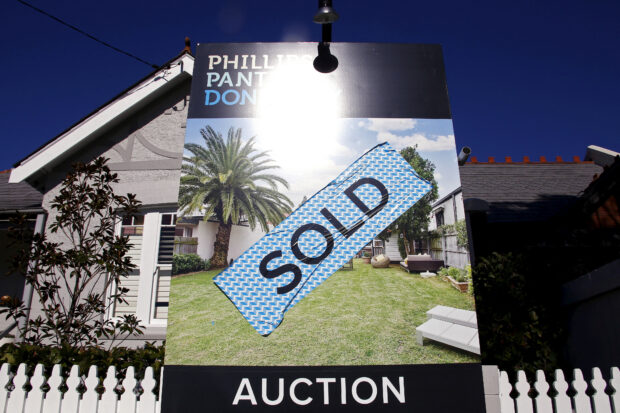
A sign stands at the front of a house after it was sold at an auction in the Sydney suburb of Waverley in Australia. REUTERS/David Gray/File photo
SYDNEY – Chances of an imminent hike in Australian interest rates grew on Wednesday after data showed house prices rebounding to near record highs and the International Monetary Fund recommended tightening monetary and fiscal policy screws to curb inflation.
Markets responded by pricing in a near-70 percent chance that the Reserve Bank of Australia (RBA) will raise rates by a quarter point to 4.35 percent when it meets on Nov. 7, ending four months of keeping rates on hold.
High readings for inflation and consumer spending had already suggested policy might be too loose, and that view was reinforced by a CoreLogic report showing house prices had regained all the ground lost during the RBA’s previous 12 rate hikes.
READ: Australia inflation surprisingly strong in Q3, adds to rate risk
“The turnaround in property prices has been quite remarkable,” declared Gareth Aird, head of Australian economics at CBA. “The RBA’s 400 basis points of tightening reduced home borrower capacity by 30 percent , but property prices are now back to their previous peak.”
So far this year, values in Sydney, Perth and Brisbane are all up more than 10 percent , adding billions to household wealth at a time when the RBA would really rather they not be spending.
READ: Australia Sept retail sales climb at fastest pace in 8 months
A separate report from PropTrack foresaw further gains ahead given booming migration, a tight rental market and a supply squeeze as home building lagged far behind population growth.
IMF weighs in
The IMF also weighed in on Wednesday by arguing tighter monetary and fiscal policy was needed in order to bring inflation back to the RBA’s target band of 2-3 percent .
In its regular review of Australia, the IMF staff noted the resilience of the economy as the jobless rate remained near a 50-year low of 3.6 percent , while economic output was estimated to be running at 1 percent above potential.
“Staff therefore recommend further monetary policy tightening to ensure that inflation comes back to the target range by 2025 and minimize the risk of de-anchoring inflation expectations,” they said.
They also called for different levels of government to take a more measured approach to infrastructure investment as massive projects compete for scarce resources and push up costs.
S&P Global Ratings estimates capital expenditure by Australian states and territories will be a record A$320 over the next four years.
“Each project on its own probably doesn’t add that much to national inflation,” said Martin Foo, lead analyst at S&P Global Ratings. “But the problem is that if you add up all of these projects together, then they are having a significant impact.”